WHAT IS A 'FILL' ?
A 'FILL' is a short ROLL-BURST any drummer may inject into a song, to fill up dead-spots in the music, between verses or phrases.
WHAT IS A RUDIMENT?
DRUMMING RUDIMENTS are purported to be the 'building blocks' of all rhythm. We often use rudiments as 'FILLS'.
THE COMMON NOTE-VALUE FILLS
The common SIX note-value concepts in this lesson, really ARE the MAJOR BUILDING BLOCKS of ALL rhythm, (including the rudiments!) There are others, but the patterns to follow are the patterns most often used as fills.
This lesson will serve SEVERAL PURPOSES . . .
- Almost ALL students at ANY LEVEL will add to their own arsenal of rolls and fills here.
- If you've been confused about NOTE-VALUES in the past, we'll clear up that confusion, NOW.
- This lesson should help ANY student improve their reading, writing skills.
- In general, this lesson will help lead all students to increased confidence and ability with written drum notation.
- At the same time, this lesson may possibly increase the students creative-(jamming)- imagination by a factor of 10.
- This knowledge will help students discover, create and re-invent the various rudiments in a NATURAL way, as they listen, jam and play along with recordings for FUN.
STUDY THIS LESSON WITH A VERY OPEN MIND. Think about it often, then return to it periodically. Learn to add ALL these roll types to your bag of JAMMING tricks and techniques. Every roll (fill) on this page will eventually become a BIG part of your individual playing style. Each fill needs to be MEMORIZED. Add all of these ideas to your personal TOP SHELF. Don't be satisfied until each has become a regular part of your playing routines. Perfect each to a point where they become ROUTINE JAMMING HABITS. These fills may be combined MILLIONS OF WAYS.
CONSIDER THIS VERY BOLD STATEMENT . . .
WITH ONLY A FEW EXCEPTIONS . . .95% OF ALL 'FILLS' being played on ANY RECORDINGS will be based on these 6 NOTE-VALUE concepts. Total comprehension of this material will translate into INSTANT RECOGNITION. As we HEAR various combinations of these NOTE VALUE fills being played on the popular recordings we enjoy every day, we'll instinctively know and recognize those NOTE-VALUES by sound and/or sight. Ultimately, our listening skills develop, while at the same time we'll be sharpening our reading and writing skills too.
- Quarter triplets = 3 + 3 (per measure)
- 8TH-NOTES = 4 + 4 (per measure)
- 8TH-TRIPLETS = 6 + 6 (per measure)
- 16THS = 8 + 8 (per measure)
- 16TH TRIPLETS = 12 + 12 (per measure)
- 32ND-NOTES = 16 + 16 (per measure) Optional, for later study . . .
- 32ND TRIPLETS = 24 + 24 (per measure)
THE NUMBERS ARE IMPORTANT . . .
Look at the numbers, off to the right of each value. Visualize the meanings of those number patterns?It's a MATH thing . . . See and remember the numbers as you practice. Learn to think of the fills as numbers, rather than by their names. The numbers will always be the same, though the names tend to change as we use these SAME numeric fills with various (BASIC DANCE BEAT) tempo extremes.
These fills will work with ANY beat. They will 'feel' nearly the same ANY time we use them, and the numbers will always be relative though the note-value names may change.
Look especially at the roll you may already know best, the 16th (single stroke) roll.
Notice the numbers are 8 + 8.
What does this mean? It means that each repetition of the roll will contain 8 notes per half measure, or 16 notes to a whole measure of 4/4............................................................................
NOTE: Half-measure 'fills' are the easiest to learn. Once the
half-measure fills have been mastered . . . it becomes VERY EASY to
extend ANY fill to ANY length by doubling, tripling or quadrupling the
original idea. No mistakes! EVER!
............................................................................
THE CLASSIC NOTE-VALUE FILLS:
We're starting at the beginning here, but it 'may' be good to jump down and study the 16th-note (8+8) fill first, since you may already know that one. It's the most over-used fill in modern pop styles. Nearly every drummer learns it first.
The sound and video files are VERY IMPORTANT! Listen to each midi file several times while visualizing the math or numerical concept of each NOTE-VALUE, fill type!
NOTE-VALUE FILL TYPE #1
QUARTER TRIPLETS:
If we want to play Quarter Triplets . . . we'll need to play 3 + 3 notes, VERY SLOWLY. . . while maintaining a constant tempo on the bass drum (right foot.) The bass MUST remain steady as we execute this fill . . .
Quarter triplets are so slow, they can easily played with one hand by anyone, (no matter what level.) The really HARD part is keeping the bass steady as we evenly spread 3 notes across the SAME time-frame where 4, 6, 8, 12, 16 or 24 notes may be played in the later rolls.
I think they sound better when played as two simultaneous notes with both the right and left hands. I've written them that way here. YOU decide. The rhythm pattern is the important thing. It doesn't matter if we use one-hand or both.
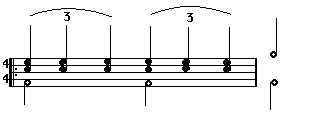
 Listen, then mimic the sound . . .
Listen, then mimic the sound . . .
Now try adding 4th (quarter) triplets to the 8th rock beat.
 LISTEN TO IT!
LISTEN TO IT!
![]() VIDEO: Click here to 'Play', see, and hear the QUARTER TRIPLET FILL WITH THE 8TH ROCK BEAT.
VIDEO: Click here to 'Play', see, and hear the QUARTER TRIPLET FILL WITH THE 8TH ROCK BEAT.
I like to play simultaneous 4th triplets on both the hi-tom and the snare, though it isn't totally necessary. Play them anywhere you wish, with either (or both) hands.
NOTE-VALUE FILL TYPE #2
8TH NOTES:
These are easy . . . You can do these with one hand or both! Again, it's your choice.
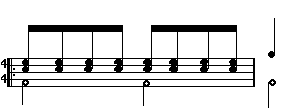
 Hear it.
Hear it.
We are ALREADY playing 8th-notes on the hi-hat . . . as we are playing the 8th rock beat. Start with the fill, go into the beat, then cycle it a few times without stopping.
NOTICE THAT THIS ROLL IS BASED ON 4+4 NOTES though the notes are spaced into the SAME TIME FRAME as when we played 3+3 (quarter triplets) earlier.
 Listen and memorize the sound . . .
Listen and memorize the sound . . .
LISTEN TO EACH OF THE SOUND-FILES SEVERAL TIMES!
MEMORIZE THESE DIFFERENCES IN SOUND.
![]() VIDEO: Click here to 'Play', see, and hear the 8TH-NOTE FILL WITH THE 8TH ROCK BEAT.
VIDEO: Click here to 'Play', see, and hear the 8TH-NOTE FILL WITH THE 8TH ROCK BEAT.
NOTE-VALUE FILL TYPE #3
8TH NOTE TRIPLETS:
You'll probably need both hands on this one . . . Practice this repeatedly.
REMEMBER!
The bass-drum tempo must remain at EXACTLY the same tempo for EACH of these NOTE-VALUE fills. If the tempo of your BEAT changes . . . so will the speed of ALL these fills. The bass-drum tempo will bind everything together.
Here is a half-measure 8th triplet fill. You may return directly to the beat after one rep of the fill or you may play two or more reps as shown in the example immediately following this one.
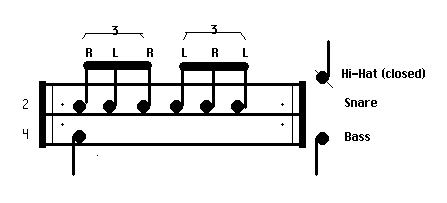
 Many students have trouble REMEMBERING this sound. Listen to it MANY times.
Many students have trouble REMEMBERING this sound. Listen to it MANY times.
Focus on that bass drum . . . keep it steady . . . repeat the roll until it flows well . . . then go INTO the beat . . .

 Listen and BURN it into your memory.
Listen and BURN it into your memory.
Cycle back and forth between the beat and roll until it's easy to do. KEEP THAT BASS TEMPO STEADY. We're spreading these six notes over the SAME time-frame where 3 + 3 and 4 + 4 were placed earlier.
![]() VIDEO: Click here to 'Play', see, and hear the 8TH TRIPLET FILL WITH THE 8TH ROCK BEAT.
VIDEO: Click here to 'Play', see, and hear the 8TH TRIPLET FILL WITH THE 8TH ROCK BEAT.
NOTE-VALUE FILL TYPE #4
16TH-NOTE, SINGLES DOUBLES OR PARADIDDLES . . .
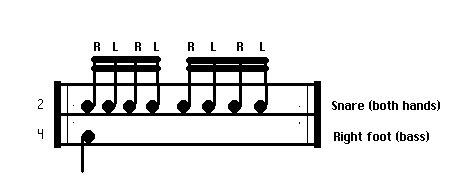
 Hear this CLASSIC fill. Play it on ANY drum.
Hear this CLASSIC fill. Play it on ANY drum.
Play a steady stream of 8 + 8. You'll be playing a BASS DRUM (right foot) on the first of every 8 notes. Or, 8 + 8 + 8 + 8 indefinitely.
THE BASS DRUM IS CRUCIAL HERE. DON'T LEAVE IT OUT. Repeat, repeat, repeat . . . playing the bass along with the 1st note in every group.
Once you have the roll flowing . . . BREAK OUT OF THE ROLL and go into a Basic 8th Rock beat . . . without changing the tempo (speed) of the bass.

NOTE: The Paradiddle (RLRR LRLL) stroke pattern may be used above if you choose.
 Hear it. Then experiment with variations all around the drum set.
Hear it. Then experiment with variations all around the drum set.
![]() VIDEO: Click here to 'Play', see, and hear the 16TH PARADIDDLE FILL WITH THE 8TH ROCK BEAT.
VIDEO: Click here to 'Play', see, and hear the 16TH PARADIDDLE FILL WITH THE 8TH ROCK BEAT.
The bass should ALWAYS remain constant!
(I know I'm sounding like a broken record . . . but it's SO important!)
You'll come out of the roll . . . and return to the hi-hat (and the beat) on any bass drum note. Continue to cycle from the roll (fill) into the beat and back until it feels easy and natural.
LATER . . .
You may extend the fill as long as you like. Your fill may be of any length! Play it on ANY drum or combination of drums. JUST KEEP THE BASS DRUM CONSTANT ALL THE TIME. THE KEY ELEMENT IS THE BASS.
We may play ANY of these fills . . . ANYWHERE in a song that we choose . . . and our fills (or fill combinations) may be ANY LENGTH we choose. We'll always know to resume the beat on a bass drum note. The timing is consistently maintained as right-foot learns to HOLD the count.
NOTE-VALUE FILL TYPE #5
16TH TRIPLETS:
We are all ONLY human! The tempo of our beat must be REASONABLY SLOW here or we may not be able to keep up. Limit this fill to slower tempos for awhile, until the super-human ability develops. It'll come with enough practice! Most students will need 4 to 5 hours of eventual practice on this one, before maximum speed will result. :>)

(Play 'R L R L R L', for each group of six notes.)
![]() Listen. Then, build this to SUPER human speeds.
Listen. Then, build this to SUPER human speeds.
Imagine cramming 12 + 12 notes into the SAME time-frame where we just played 6 + 6 (8th triplets) above. If you can do it while maintaining that constant bass tempo . . . you'll be playing 16th triplets.
It's a VERY impressive fill or roll! It'll turn heads every time it's used . . . even in moderate tempos. But that kind of speed will require considerable practice. Some of you may have your work cut-out for you here, but . . . I'll promise this one thing:
"Every hour devoted to this roll will improve COORDINATION AND SPEED by a factor of 3".
Yes! I'm saying you will become 3 times the drummer you are now . . . with one hour of dull, boring practice on this 12 + 12 (16th triplet) roll!
Watch a great HBO movie as you repeat this 12 + 12 (16th triplet roll), endlessly. It will pay-off BIG . . . and you'll also have a super excuse for enjoying a good movie.

(double groups of 6 / only one bass)
 LISTEN TO IT . . . I've set the tempo to about half-speed here. You'll eventually want to develop all these fills to about double this tempo.
LISTEN TO IT . . . I've set the tempo to about half-speed here. You'll eventually want to develop all these fills to about double this tempo.
![]() VIDEO: Click here to 'Play', see, and hear the 16TH TRIPLET FILL WITH THE 8TH ROCK BEAT.
VIDEO: Click here to 'Play', see, and hear the 16TH TRIPLET FILL WITH THE 8TH ROCK BEAT.
NOTE-VALUE FILL TYPE #6
32ND PRESS ROLL:
You'll need sticks for this . . . preferably on a real snare drum. This fill is usually MUCH easier to learn than the 16th triplet fill . . . because we'll use a 'trick' to create the illusion of speed. By learning to 'crush' our notes . . . we'll actually be playing twice as many notes in the same relative time frame by cheating or 'crushing' . . . in order to get two notes for one . . .
Here we'll simply play the 8 + 8 roll . . . but we'll 'crush' every note. Thus creating two notes for every stroke. We end up with 16 + 16 by using the 'crush' or 'press' trick, making the sticks growl on the drum head.
TO CRUSH A NOTE . . . grip the stick very tightly with the thumb and 1st finger. No other fingers should be touching the sticks . . .
LAY the stick into the head and force it to 'growl', producing a 'brrr' sound. It's a trick! Squeeze the stick tightly between the thumb and finger as you strike the head. Make it growl!
Now do it with each hand . . . building speed, placing a bass on the first of every 8 strokes . . . just like the 8 + 8 roll . . . but now we are 'growling' EVERY stroke.
This is called a 32nd press or crush roll. It's very useful as a fill with 8th rock or ANY beat.
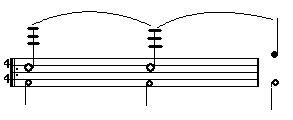
NOTE: Since we're actually playing 32 notes in the above fill, music notation writers tend to make their job easier by writing and tying one note to another. The three crossbars and ties on the half-notes above are indicating that we'll actually play a 32nd note press or 'crush' roll for the entire length of the measure. Writers may use many conventions to describe this same roll . . . (ie; 2 half-notes with three slashes, 1 whole-note with 3 slashes, etc., etc.)
 Listen to it, but use your imagination . . .
Listen to it, but use your imagination . . .
NOTE: I had to cheat a little to achieve a semi 'crush' sound here . . . My midi file maker simply can't do a respectable 'crush'. Next, drop it into a beat . . . keep cycling from the roll to the beat and back, until you can play it smoothly.

 Not the sound I want . . . but it's better than nothing.
Not the sound I want . . . but it's better than nothing.
![]() VIDEO: Click here to 'Play', see, and hear the (CRUSHED) 32ND FILL WITH THE 8TH ROCK BEAT.
VIDEO: Click here to 'Play', see, and hear the (CRUSHED) 32ND FILL WITH THE 8TH ROCK BEAT.
DISCLAIMER: Again, I must apologize for the above midi sound file. It doesn't sound at all like a 'crush' roll should sound. The application I use to make these midi files simply can't manage a 'crushed' sound. What you are hearing is much too 'open'. A crush roll should sound more like you might hear just as a firing squad is about to execute the prisoner in the movies. Use your imagination a little, here. Play 8 notes per bass . . . and 'growl' or 'crush' each stroke. The video I added later, is closer to what we want.
NOW, FOR SOME COOL TIPS AND TRICKS
- Try these same rolls with 16th 4/4 . . . They're the same, but the bass notes will match the bass notes in the beat. You'll only play half as many bass notes in your rolls here.
- Try these same rolls with Swing and Shuffle. It's exactly the same as with 8th rock . . . Start your fills on any bass . . . and return to the hat on any bass. Extend the rolls to any length, play them to any drum or combination of drums. as you wish. Play slow tempos ONLY, while learning.
- Try these same rolls with Quarter rock 4/4 . . . Now you'll either want to double the number of bass notes in each fill (to match the beat), which may be VERY hard to do . . . Or . . . you can simply play the rolls as you learned them . . . it'll mean that the bass drum will be cut to HALF of its '4th rock' tempo.
The rolls will ALWAYS 'feel' the same! Only the BASS DRUM will change as we adapt these fills to the other basic dance beat categories . . .
The NOTE-VALUE NAMES of the fills tend to change too . . . as we play these fills with tempo extremes. That's why the NUMBERS (3+3, 4 +4, etc., etc.) help simplify the entire process . . .
THE FANCY RIBBON . . .
MIX AND MATCH ENDLESSLY . . .
There is almost no end to the ways you can combine all these roll types to produce ENDLESS VARIETY as you play your fills.
STICK WITH 8TH ROCK 4/4, UNTIL YOU HAVE ALL THESE FILLS ADAPTED TO YOUR STYLE. Then, try them with virtually ANY beat on virtually ANY song!
THE 'SECRET' TO ALL THIS DESERVES REPEATING, ONE MORE TIME.
KEEP THAT BASS TEMPO ROCK-SOLID-STEADY AT ALL TIMES!
Make your rolls and fills fit the tempo of the beat . . . (not the other way around.)
WHAT ABOUT RUDIMENTS?
- (CLICK HERE to see 'more in-depth rudimental info' and the twenty-six N.A.R.D. rudiments.)
Supposedly, (at least, in theory), the rudiments train (or teach) the hands and feet to execute the rhythmic 'ideas' of the mind. I tend to agree and disagree at the same time. Though the rudiments are extremely important, they are also very dry, boring, complex and often impractical.
At the moment, there are nearly 400 documented rudiments on various roll-charts around the World. 95% of those rudiments are made up of THE BASIC 6 ROLLS you've learned in this lesson. Common-sense dictates that almost all student-anxiety and confusion concerning rudiments may be simplified and solved by mastering these SIX NOTE-VALUE fills and rolls, first.
By conquering that steady bass flow, while playing THESE SIX NOTE-VALUE fills . . . you'll discover that MOST (but not all) OF THE RUDIMENTS WILL COME NATURAL.
AFTER ALL . . . the rudiments are nothing more than these SAME NOTE-VALUES . . . combined in various, assorted ways.
Use your imagination as you jam with recordings. LISTEN to the fills and rolls the recorded drummers are playing. Analyze, identify and imitate what you are hearing! Then, invent and create your OWN ideas within the same time frames.
DO NOT BE AFRAID to inject your own imagination and creativity into the music that you play. That's exactly what the recorded drummers are doing!
BUT, be certain you have completely memorized THESE ESSENTIAL NOTE-VALUE fill and roll options, so that you'll be working with a FULL PALETTE of rhythmic color, at all times . . .
These fills, once memorized, will add variety to your imagination tool-box.
- ...............................................................................
PARTING THOUGHT . . . If we 'crush' the 16th triplet, (fill #5 , above), we'll theoretically achieve 24 + 24 or 48 notes to the measure. This will increase our basic note-value roll/fill types to a total of seven. It is written as a 32nd triplet when used within the basic 8TH ROCK, SWING OR SHUFFLE 4/4 DANCE BEAT structures.
- ...............................................................................
If you have added the above lesson to your arsenal of onstage tricks . . . It's time for you to move on up to GURU STATUS . . .
If it's all still a little vague . . . DON'T WORRY! MOVE ON UP, ANYWAY!
Finite To Infinity
3 very important questions
IS IT POSSIBLE THAT YOUR 'NATURAL GIFT' OF RHYTHM CAN BE DOUBLED WITH ONLY A LITTLE ADDITIONAL (PREVIOUSLY UNAVAILABLE), KNOWLEDGE?
IS THERE A 'KNOWLEDGE GAP' IN YOUR OWN UNDERSTANDING OF 'RHYTHM'?
IS IT POSSIBLE TO GAIN A COMPLETE AND THOROUGH UNDERSTANDING OF 'ALL RHYTHM', WITHIN ONLY A COUPLE HOURS OF EASY, AND FASCINATING, STUDY ?
Answers: YES! YES! YES!
Get All Products Here
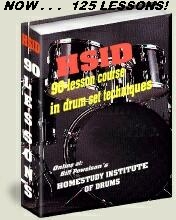
GET ALL THE PRODUCTS AT ONE LOW PRICE.
SURPRISES ABOUND!!!! . . . For those with a bit of generosity in their soul.
CLICK HERE , to see what I mean.
Intermediate & Advanced Drummers
- Drum Instructors Wanted
- Teach My Lessons and Methods
- Up to $60.00/hour
Pre-School Drummer?
Can we teach rhythm to pre-schoolers? YES!
This is a very short course, designed to help adults plant the seeds of rhythm into children of nearly any age. Click Here!!
Make CASH $$$ Now!!!

FREE ELECTRONIC BOOK BONUS (also included) BUSINESS OPPORTUNITY:
- * MAKE BIG MONEY SELLING USED DRUMSETS!
- * INSIDER HARDBALL-BUYING-TIPS AND SECRETS.
- * UNIQUE RECOVERING SECRETS
Support Us Today!!
Support this site and and gain an advetising bargain with the deal. Place a permanent ad here.
